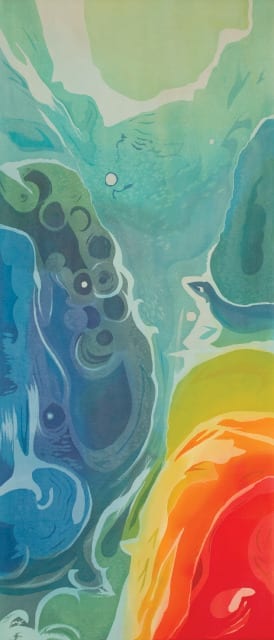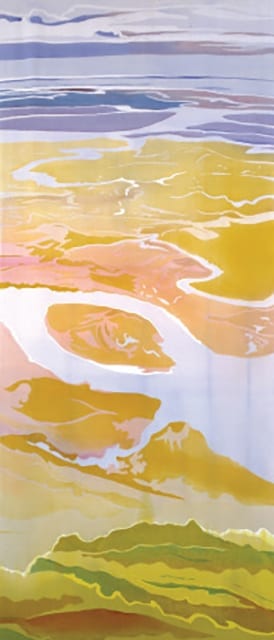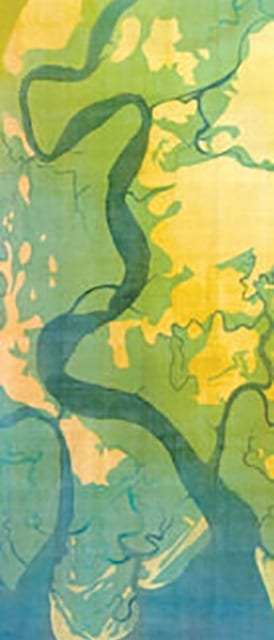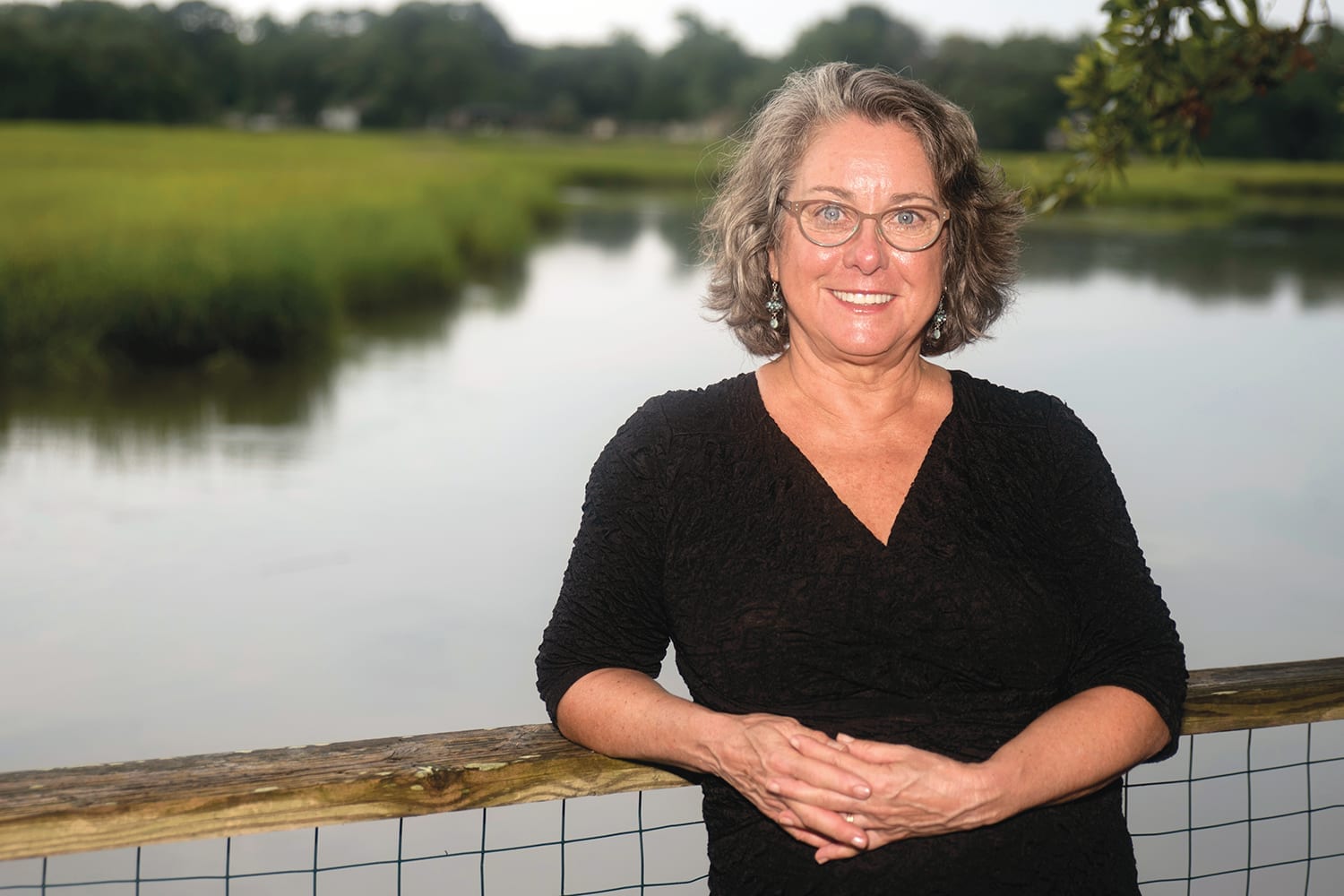A mere 10 minutes from downtown Charleston — just over the James Island Expressway, followed by a left turn, then a right — one comes to a dirt driveway with trees arching overhead. At the end of this drive is the home and studio of Mary Edna Fraser, which sits on a tidal creek overlooking the marsh. The inside of the house is like a captain’s lair, filled with the trappings and artifacts from explorations across the world. Each room, brimming with textiles, instruments, books, and curio, is an encyclopedia come to life.
Although Fraser now lives on the water, as a child, she grew up in the sky, often soaring over the Southeastern seaboard in her grandfather’s vintage Ercoupe plane. Her memories of those aerial expeditions, which mapped the coastal-ways and land below, remain vivid and have been influential in her work.
In 1979, while taking aerial photographs of the Georgia Sea Island on a flight with her brother, the idea came to Fraser of translating the aerial view onto silk.
Fraser is skilled at flying, but she and her husband, John, joke that they have struck a deal that keeps their marriage intact: she always flies with a licensed pilot. She handles take-off and landing, but during the flight, she sets up her shot, then passes over the controls to her co-pilot so she can photograph.
Back on terra firma, Fraser begins the task of transcribing those images onto swathes of silk employing the ancient medium of batik, an elaborate dye-resist process in which layer upon layer of wax and dye are applied in meticulous sequence.
The skyward vantage naturally led Fraser to consider all strata, looking both heavenward and to the depths of the ocean floor.
Over the past 30 years, Fraser has revitalized the rich tradition of artists and scientists working side-by-side. She was NASA’s artist of the year in 1995 and the first woman to be honored with a one-person exhibit at the Smithsonian National Air and Space Museum.

“North Edisto”
For Mary Edna Fraser, the link between the disciplines of art and science is innate. “Scientists ask questions and solve problems. They think on their feet, and they try to answer questions — they’re always thinking outside the box, just like an artist.”
She has collaborated with planetary scientist Ted Maxwell, coastal geologist Orrin Pilkey, and marine biologist and oceanographer Cindy Lee Van Dover. These partnerships have led her to reflect on the solar system, “mapping the planets in silk,” study changes in the shorelines from the Southeast to the Great Barrier Reef, and explore the depths of the Atlantic Ocean.
Her batiks are maps in their own right. Maps guide us and provide a sense of place. “All of my work is about a sense of place,” Fraser explains.
Yet in as much as the batiks reference physical features, they are also abstract works that transmit something beyond the concrete, communicating to the viewer on an emotional register.
“That’s a thing the artist can do: emotionally bring the audience to the core of what is being taught,” Fraser says.

“Bajan Mud Volcanoes”

“Romains Refuge”

“South Edisto”
The German artist Paul Klee famously wrote, “Art does not reproduce the visible; rather, it makes visible.” Fraser’s unique use of batik reveals perspectives the human eye and traditional camera cannot reveal.
She doesn’t rely on the imagery, charts and maps provided by her scientific counterparts. Once the process of drawing on the batik begins, she leaves the real and goes to the abstract. She draws from what she calls her “visual memory of flight” and infuses the work with her painterly and feminine intuition.
There’s a fascinating, alchemic force to Fraser’s work, where the ancient technique of batik meets cutting-edge science. Fraser doesn’t simply reproduce visual information, she transforms it into a story, creating beautiful, narrative landscapes. She is able to illustrate dynamic geologic change, shifts in unseen terrains and galaxies; she highlights the fragility of ecosystems and draws attention to rising sea levels.
“The science is dense, and a lot of the time the story is difficult … it’s long, and by making one piece of art to represent a piece of science, you can bring the viewer in gently to learn about it,” Fraser explains.
The work is not merely educational. It is transcendental. Fleeting moments — what Fraser calls “snapshots in geologic or galactic time” — are memorialized onto silk using the slow, meditative batik process. One large-scale piece can take months or even up to a year to complete. The hanging batiks, floating worlds suspended above, are weighted with a sense of gravity, humbling the viewer.
A pioneer in the medium of batik, Fraser has taught and lectured internationally, and her pieces have been exhibited worldwide. She is the 2016 recipient of the Elizabeth O’Neill Verner Governor’s Award for the Arts, presented by The South Carolina Arts Commission.
These days, Fraser finds herself recasting her relationship with nature through the media of plein air and oil painting. As ever, she enacts a delicate play between the representational and the abstract, relying on memory, emotion, and exacting geography in evoking a sense of place. She’s undertaken a project to capture the beauty of our national parks. Perhaps a monumental task for some; for Fraser, it’s a calling she readily accepts.
By Abby Deering
Editor’s note: Artworks have been cropped or modified for format.

